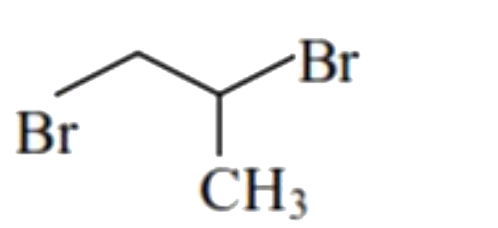Explore topic-wise InterviewSolutions in .
This section includes InterviewSolutions, each offering curated multiple-choice questions to sharpen your knowledge and support exam preparation. Choose a topic below to get started.
| 93251. |
1 mol of electrons pass through each of the solution of AgNO_(3), CuSO_(4) and AlCl_(3)when Ag, Cu and Al are deposited. Molar ratio of their deposition will be: |
|
Answer» `1:1:1` |
|
| 93252. |
1.0 molal aqueous solution of an electrolyte X_(3)Y_(2) is 25% ionized. The Boiling point of the solution is (K_(b) of H_(2)O=0.52K kg mol^(-1)) |
|
Answer» |
|
| 93253. |
1 mol of [Agl]I^(-) can be coagulated by: |
|
Answer» 1 mol of `PB(NO_3)_2` `2[Ag]I^(-) =- Pb(NO_3)_2` `THEREFORE [Ag]I^(-)=-1/2 Pb(NO_3)_2` |
|
| 93254. |
1 mol of A and 0.5 mol of B were enclosed in a there litre vessel The following equilibrium was establised under suitable condition: A+2B harr C At equilibrium the amount of B was found to be 0.3 mol.The equilibrium constant K_c at the experimental temoerature will be : |
|
Answer» 11.1 |
|
| 93255. |
1 mol BaF_(2)+2 mol H_(2)SO_(4) rarr resulting mixture will be neutralised by |
| Answer» Answer :B::C | |
| 93256. |
1 mm Hg represents a pressure of |
|
Answer» `101.3"N m"^(-2)` `THEREFORE"1 atm = 101325/760 N m"^(-2) = "133.3"N m"^(-2)` |
|
| 93257. |
1 ml of hydrogen gas at NTP contains moleculesequal to |
|
Answer» `2.6 xx 10^(21)` |
|
| 93258. |
1 ml of 0.1 N Hcl is added to 999 ml solution of NaCl . The PH of the resulting solution will be : |
|
Answer» 7 |
|
| 93259. |
1 ml of 0.1 N HCl is added to 1 L solution of sodium chloride. The pH of the resulting solution is |
|
Answer» 7 |
|
| 93260. |
1 mho is equal to |
|
Answer» 1 siemen |
|
| 93261. |
1-"Methylethylene oxide" underset(HBr)overset("excess")to X, Product 'X' will be- |
|
Answer»
|
|
| 93262. |
1- methoxy propane and 2- methoxy propane are ___________ |
|
Answer» CHAIN isomers |
|
| 93263. |
1-methoxy propane and 2-methoxy propane are |
|
Answer» POSITION isomers |
|
| 93264. |
1 M NaOH solution was slowly added to 1 L of 210 g impure H_(2)SO_(4) solution and the following plot was otained. Calculate the percentage purity of H_(2)SO_(4) sample. |
|
Answer» Solution :From the plot, we observe that when 3 L of NaOH solution is consumed, `[H^(+)]` falls to zero. In other words, 3 Lof 1 M NaOH solution is used to nirtralize 1 L of the given `H_(2)SO_(4)` solution. But 3 L of 1 M NaOH contain 3 moles of NaOH and this will neutralize 1.5 mole of `H_(2)SO_(4)`. Thus, pure `H_(2)SO_(4)` present in 1 L of 210 g IMPURE `H_(2)SO_(4)` = 1.5 moles `=1.5xx98g=147g` `THEREFORE""%" purity"=(147)/(210)xx100=70%` 
|
|
| 93265. |
1 M NaOH solution was slowly added in to 1000 mL of 183.75 g impure H_(2)SO_(4) solution and the following plot was obtained. The percentage purity of H_(2)SO_(4) sample and slope of the curve respectively are: |
|
Answer» `75%` Moles of NaOH consumed when reacted with `H^(+) = 3xx1` (because `3L` of NaOH is added with `1M` cons.) moles of `H_(2)SO_(4)` PRESENT in sample `= 1.5` (because every `H_(2)SO_(4)` has `2H^(+)`) weight of `H_(2)SO_(4)` in sample `= 1.5xx98 = 147g` `%` PURITY `= (147)/(183.75)xx100=80%` |
|
| 93266. |
1 M solution each of Cu(NO_(3))_(2) , AgNO_(3), Hg_(2)(NO_(3))_(2)andMg(NO_(3))_(2)is electrolysed using Pt- electrodes. The values of standard electrode potentials in volts are : Ag^(+)//Ag=+0.80V,Cu^(2+)//Cu=+0.34VHg_(2)^(2+)//Hg=+0.79V,Mg^(2+)//Mg=-2.37V The sequence of deposition of metals on the cathode will be |
|
Answer» `MG,AG,Cu` `AggtHggtCu`. Hence , sequence of deposition : Ag : Hg. Cu. |
|
| 93267. |
1 M solution of an acid has a pH of 5. Which of the following is the most reasonable explanation for this acid? |
|
Answer» The ACID is too DILUTE. |
|
| 93268. |
1 M NaCl and 1 M HCl are present in an queous solution. The solution is |
|
Answer» Not a BUFFER SOLUTION with `pH LT 7` |
|
| 93269. |
1 litre solution containing 4.5 milimoles of Cr_(2)O_(7)^(-) and 15 milimoles of Cr^(3+) shows a pH of 2.0. The potential of the reduction half reaction is approximately xV. Then [x] is ……… where [ ] is GIF.(E^(@) of Cr_(2)O_(7)^(2-)//Cr^(3+) is 1.33V) |
|
Answer» `E_(Cr_(2)O_(7)^(-)//CR^(3+))=1.33+0.059/6"LOG"_(10)(4.5xx10^(-31))/(2.25xx10^(-4))` `= 1.33+ 0.059/5 "log"_(10)(2xx10^(-27))` `=1.06` `=1V` |
|
| 93270. |
1litre of oxygen at N.T.P. is allowed to react with three times of carbon monoxideat N.T.P. Calculate the volume of each gas found after the reaction |
|
Answer» |
|
| 93271. |
1 litre of a solution containing 500 g of a protein exerts an osmotic pressure of 0.82 atm at 27^(@)C. The molecular mass of the protein is : |
|
Answer» 82000 `:. 0.82 XX 1 = 500/M_(2) xx 0.0821 xx 300,` `M_(2) = (500 xx 0.0821 xx 300)/0.82 = 15000` |
|
| 93272. |
1 litre of a solution containing 500 g of a protein exerts an osmotic pressure of 0.82 atm at 27^@C.The molecular weight of the protein is: |
|
Answer» 82000 |
|
| 93273. |
1 litre of 18 molar H_(2)SO_(4) has been diluted to 100 litres . The normality of the resulting solution is |
|
Answer» `0.09` N |
|
| 93275. |
1 L of a gas at S.T.P.weighs 1.97 g. What is the vapour density of the gas? |
| Answer» Solution :22.4 L of the gas at S.T.P. will weigh `=1.97xx22.4=44.1g`, i.e., MOLECULAR mass = 44.1. Hence, vapour DENSITY `=44.1//2=22.05`. | |
| 93276. |
1L of NH_(3) " at " 27^(@)C is expanded adiabatically to x litres and final temperature is -123^(@)C. What is the value of x? |
|
Answer» |
|
| 93277. |
1L to 2M CH_(2)COOH is mixed with 1L to 3M C_(2)H_(5)OH to form an ester.The rate of the reaction with respect to the initial rate when each solution is diluted with an equal volume of water will be |
|
Answer» 0.25 times `r_(i)` = k[2 M][3 M]…(i) `r_(f) = k [(2 M)/(2)][(3 M)/(2)]`…(II) On dividing (ii) by (i), we get `(r_(f))/(r_(i)) = (k[M][3/2 M])/(k[2 M][3 M]) = 0.25` `:.` The RATE of reaction becomes 0.25 times of initial rate. |
|
| 93278. |
The first compound of a noble gas known is |
|
Answer» Solution :In Ramsay - Rayleight - 2method - 9 volumns of air is USED In 1 lit- 9 VOLUMES - 990 ml , 1vol-1 0 ml |
|
| 93279. |
1 kg of an aquous solution of Sucrsop is colled and maintainedat -4^(@)C. How much ice will be separanted out if the molality of the solution is 0.75 ? K_(t)(H_(2)O)=1.876 kg "mol"^(-1)K. |
|
Answer» SOLUTION :Source is a non-electrolyte Molecular weight of sucrose `C_(12)H_(2)O_(11)=M=342 gm "mol"^(-1)` Molality of the solution `0.75m` `=0.75"mol" KG^(-1)` SOLVENT Hence weight of 1 molal solution `(256.5)/(1256.5)xx1000=204.14 gm` Weight of solvent `(H_(2)O)` present in 1kg solution `=1000-204.14 gm` SINCE depressionnin freezing point. `DeltaT_(t)=K_(t)xx(W)/(m)xx(1000)/(W)` where W= weight of solvent W= weight of the solute or `4=1.86xx(256.5)/(342)xx(1000)(W)` `:.W=348.75gm` i.e., weight of solvent required to maintain this solutionat `-4^(@)C` `W=348.75 gm` Hence rest weight of `H_(2)O` will convert into ice Hence amount of ince formed `=795.86-348.477.11 gm` |
|
| 93280. |
1. i. 2CH_(3)CH_(2)CHOoverset(Θ)overset(OH)rarr(A)oversetDeltararr(B) ii. 2PhCH_(2)CHOoverset(Θ)overset(OH)rarr(C)oversetDeltararr(d) iii. iv. 2. i. ii. A hydrocarbon (A) of the formula C_(7)H_(12) on ozonolysis gives a compound (B) which undergoes aldol condensation giving 1-acetyI cyclopentene. Identify (A) and (B). 3. Acetone and butan-2-one undergo both self and across aldol (ketol) condensations to gove aldol (ketol) which loses water to give alpha,beta- unsaturated ketones. The number of isomeric alpha,beta- unsaturated ketones formed is: i. Three iii. Four ii. Five iv. Six 4. Give the cyclic intramolecular aldol condensation of the following reactions: a. Hexane-2,5-dione underset((ii) Delta)overset((i)overset(Θ)(O)H)rarr b. Octane-2,8-dione underset((ii) Delta)overset((i)overset(Θ)(O)H)rarr c. Nonane-2,8-dione underset((ii) Delta)overset((i)overset(Θ)(O)H)rarr d. Pentane-2,4-dione underset((ii) Delta)overset((i)overset(Θ)(O)H)rarr 5. Identify the reactants that can be and that cannot be synthesised from the compounds given below. i. PhCH=CHCOCH=CHPh ii. PhCH=CHCH_(2)COMe iii. PhCH=CHCH_(2)CH_(2)COMe iv. PhCOCH=CH_(2) v. PhCH=CHCH=CHCOMe vi. 3- Ethyl -2- methyl cyclohex -2-en-one vii. 2- Methyl cyclohex -1-ene-carboxaldehyde viii. ix. 1- Hydroxy-4-methyl bicyclo [2.2.2] octan-3-one 6. Give the mixed aldol product from the reaction of crotonaldehyde (CH_(3)CH=CH-CH=O) with CH_(3)CHO |
Answer» Solution :1. i. 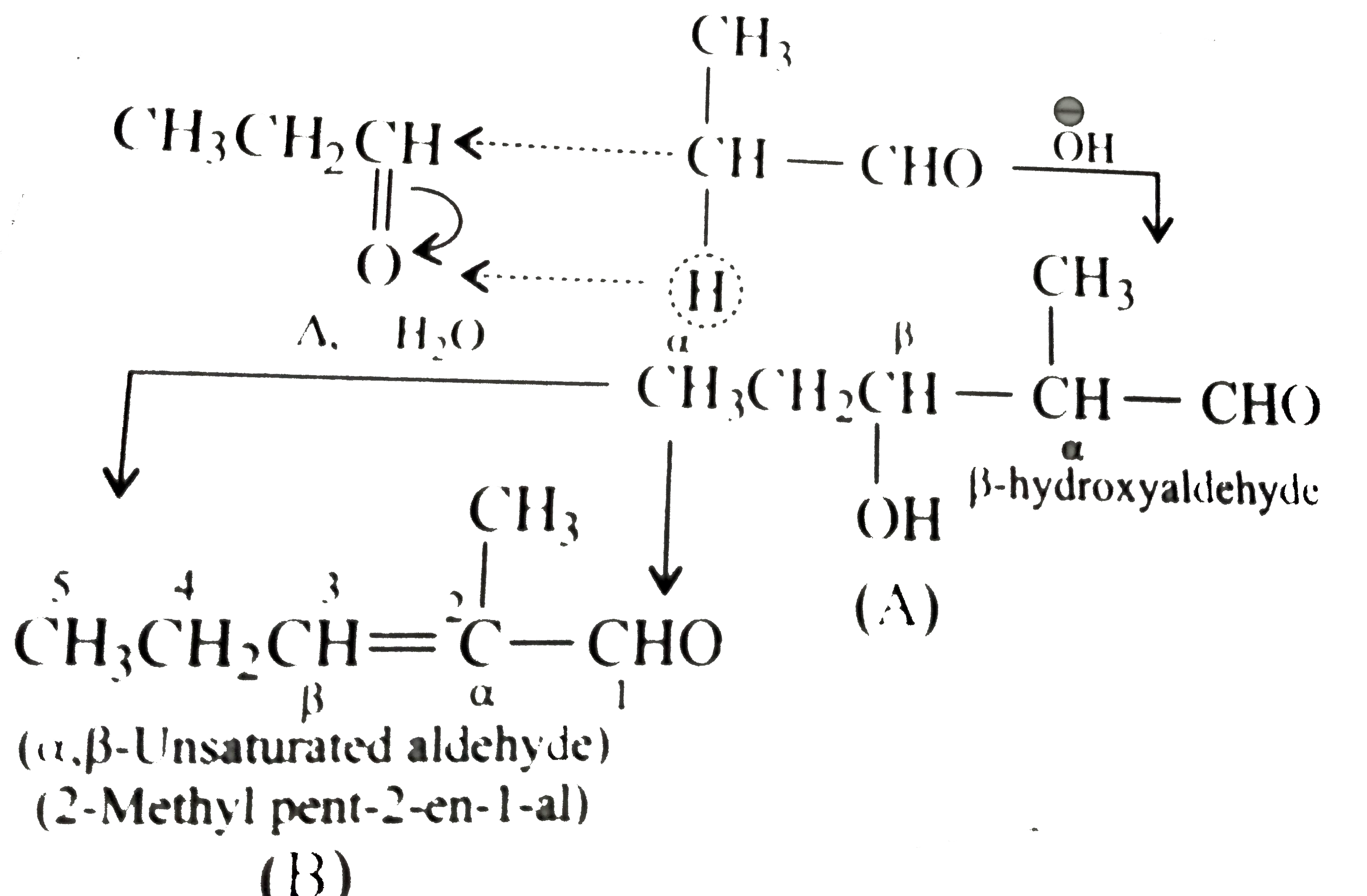 ii.  iii. 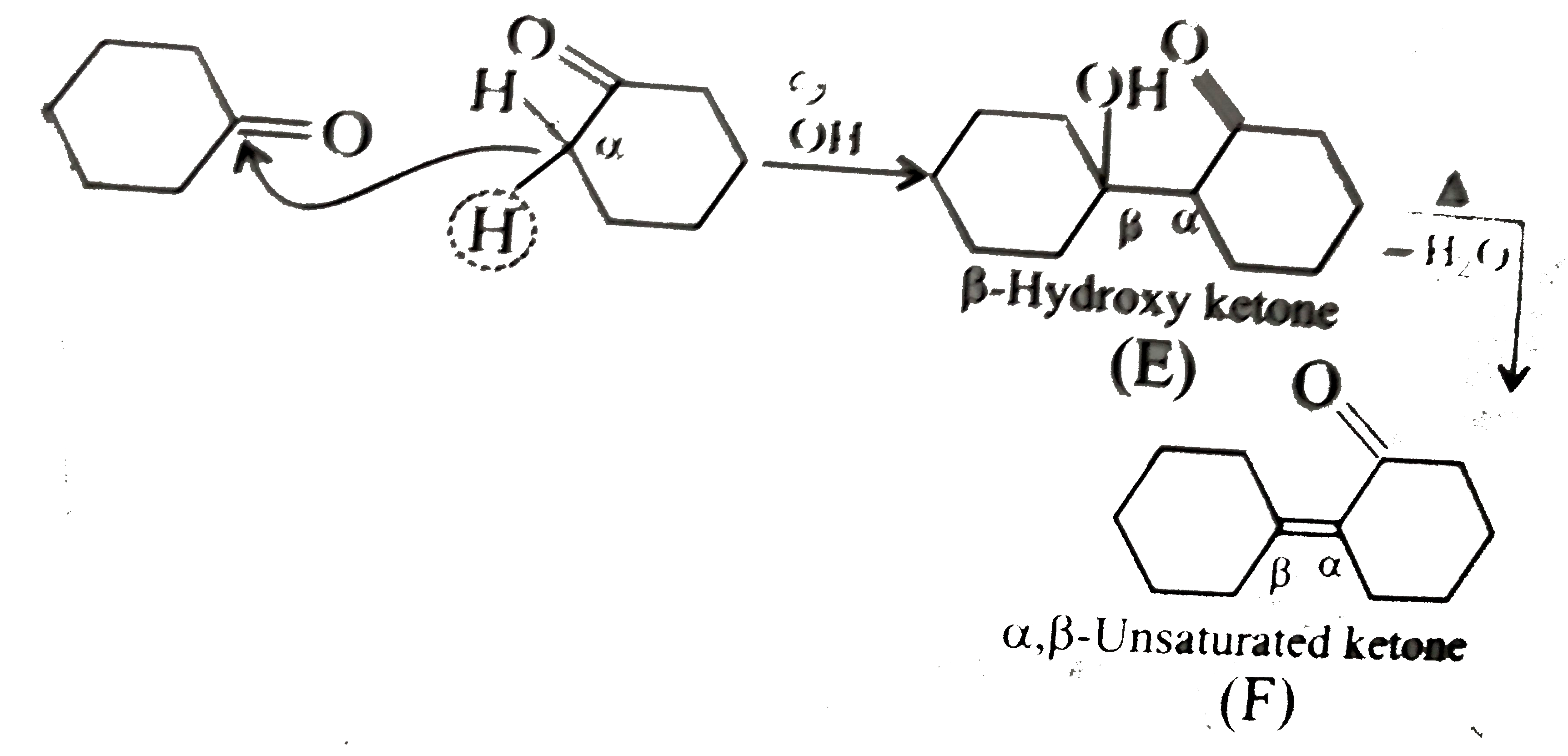 iv. 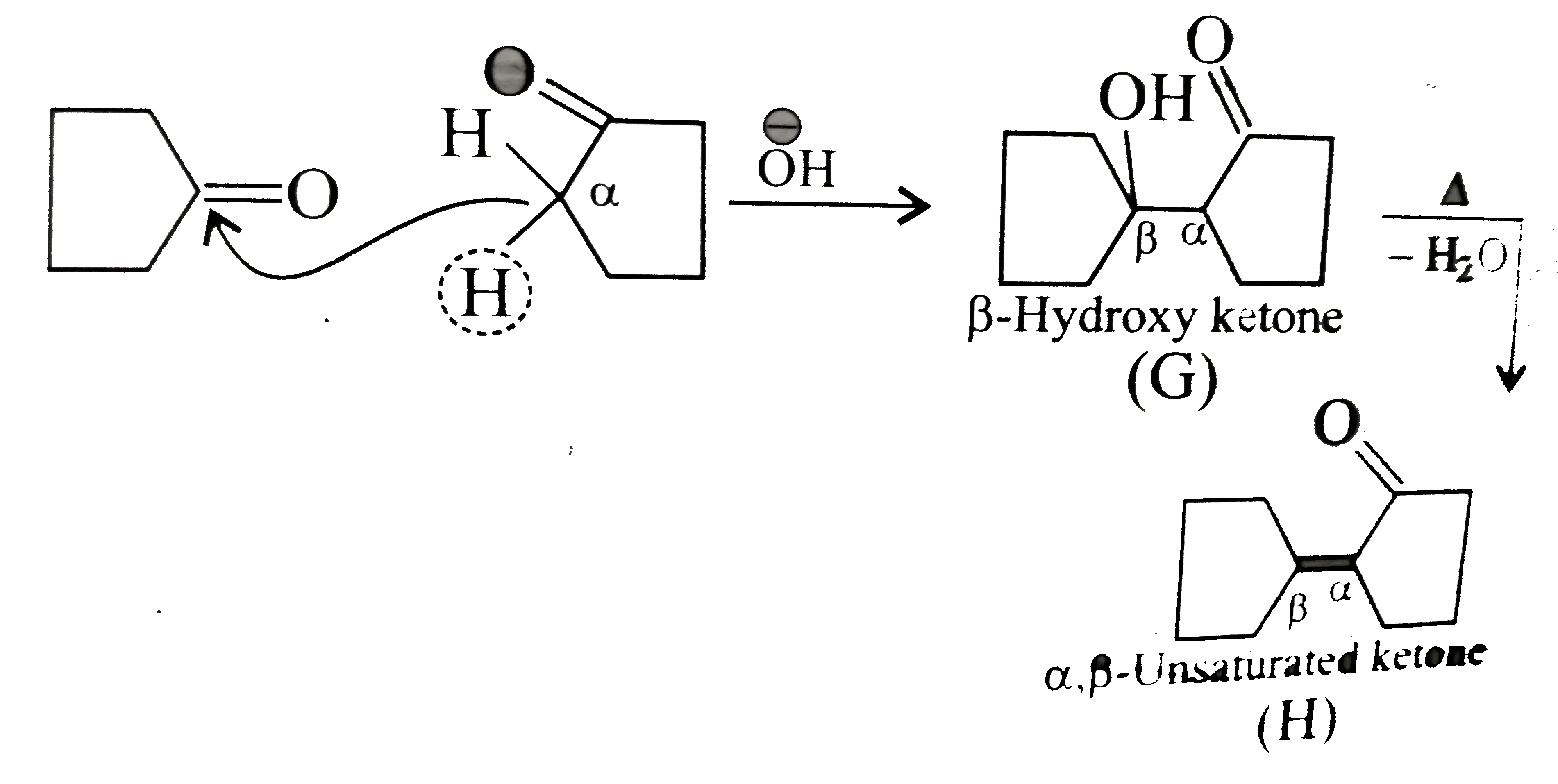 2. i.  ii. 2 D.U. in A`=((2n_(C)+2)-n_(H))/(2)=(16-12)/(2)=2^(@)` Two D.U. in `(A)` SUGGEST one `(C=C)` bond, cyclic compound obtained with base suggests ring in `(A)`.  Proceed reverse: 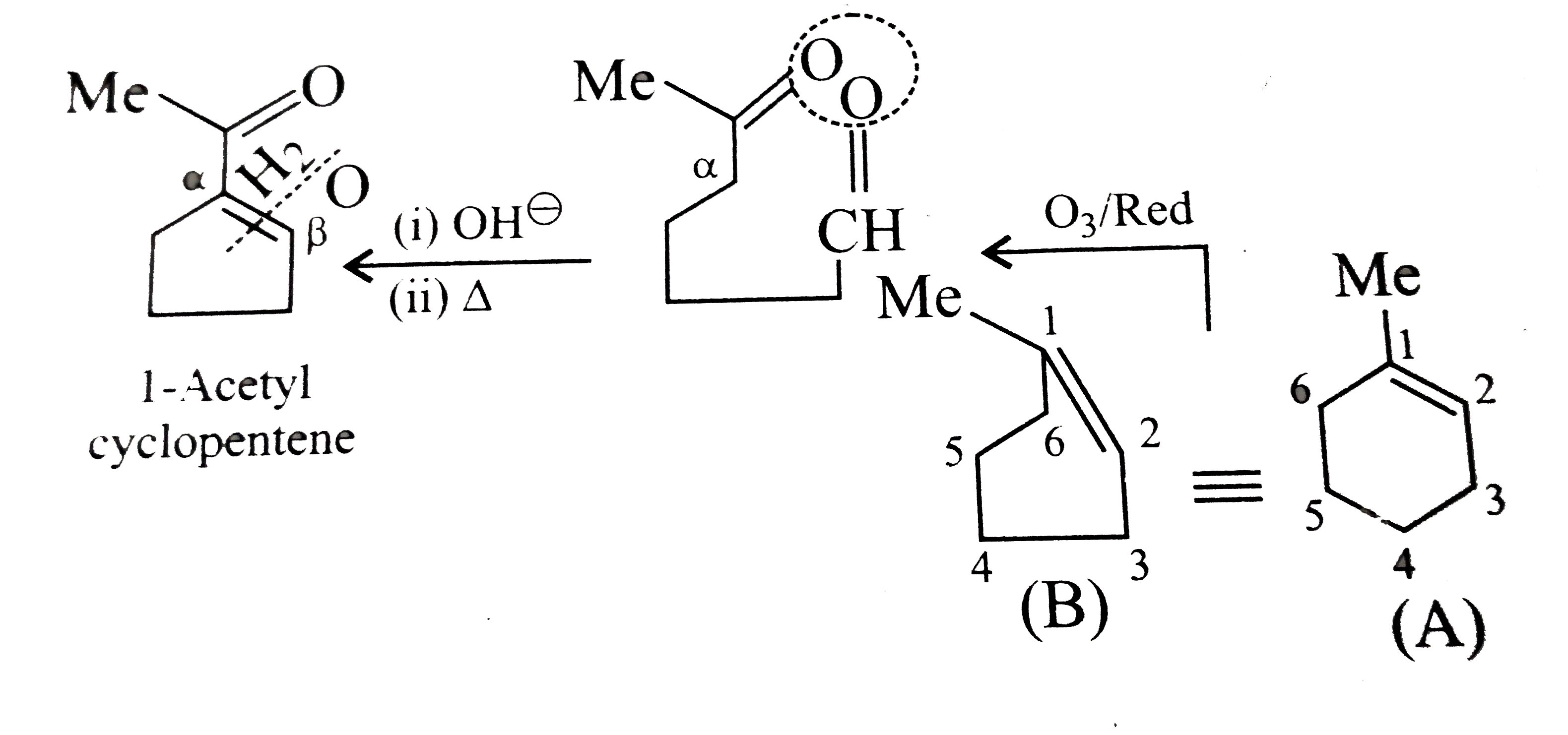 3.d. Three self and three crossed aldol condensation products: Butan`-2`-one (unsymmetrical KETONE) has two types of dissimilar `alpha-H` atoms `(overset(alpha)MeCOCoverset(alpha')H_(2)Me)`, and acetone (symmetrical ketone) has only one type of similar `alpha-H` atoms `(overset(alpha)MeCOoverset(alpha)Me)`. 4 a. 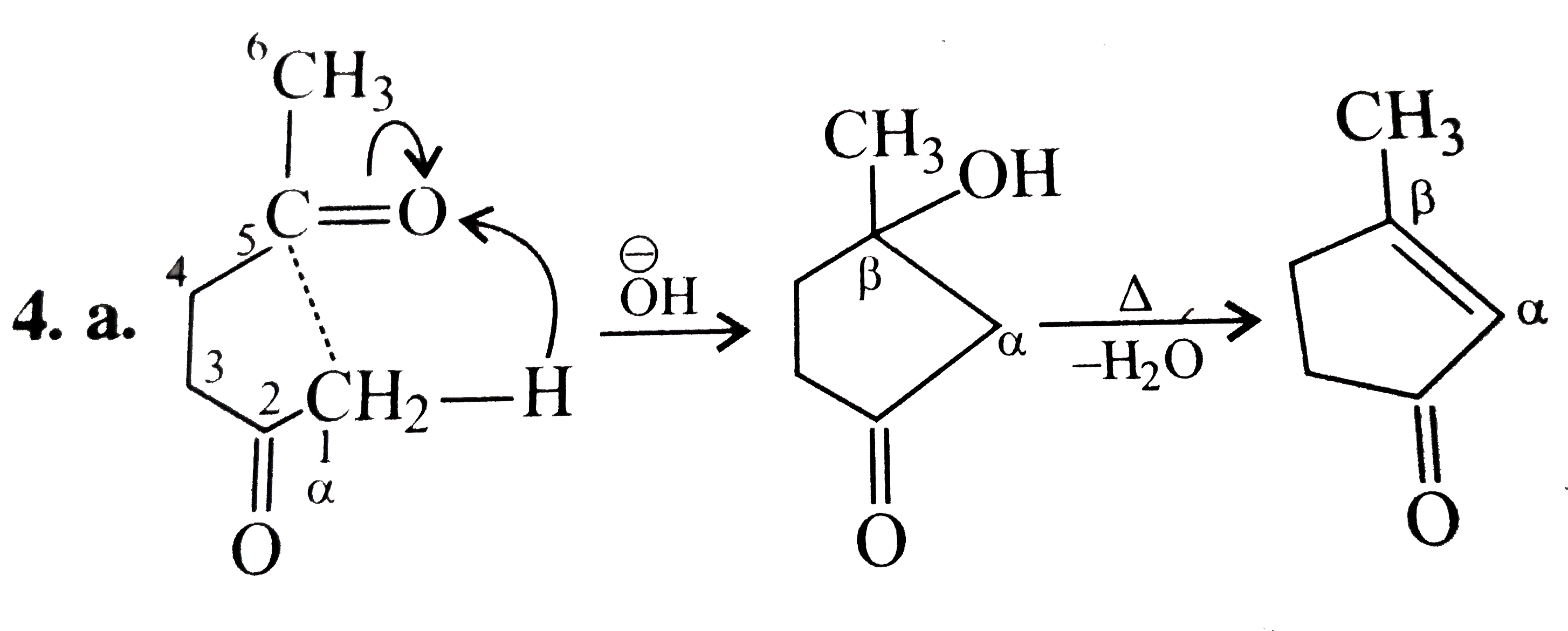 b. 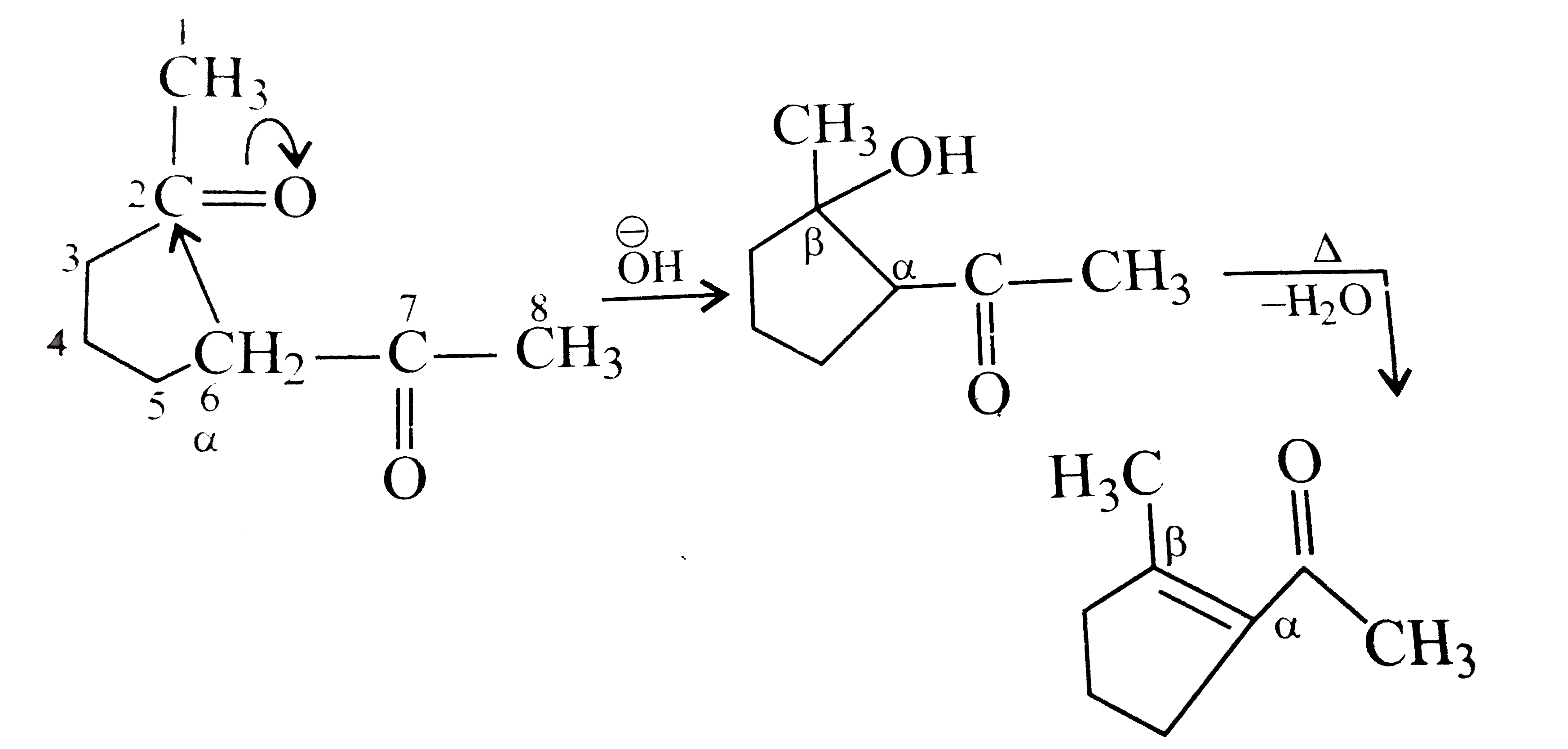 c. 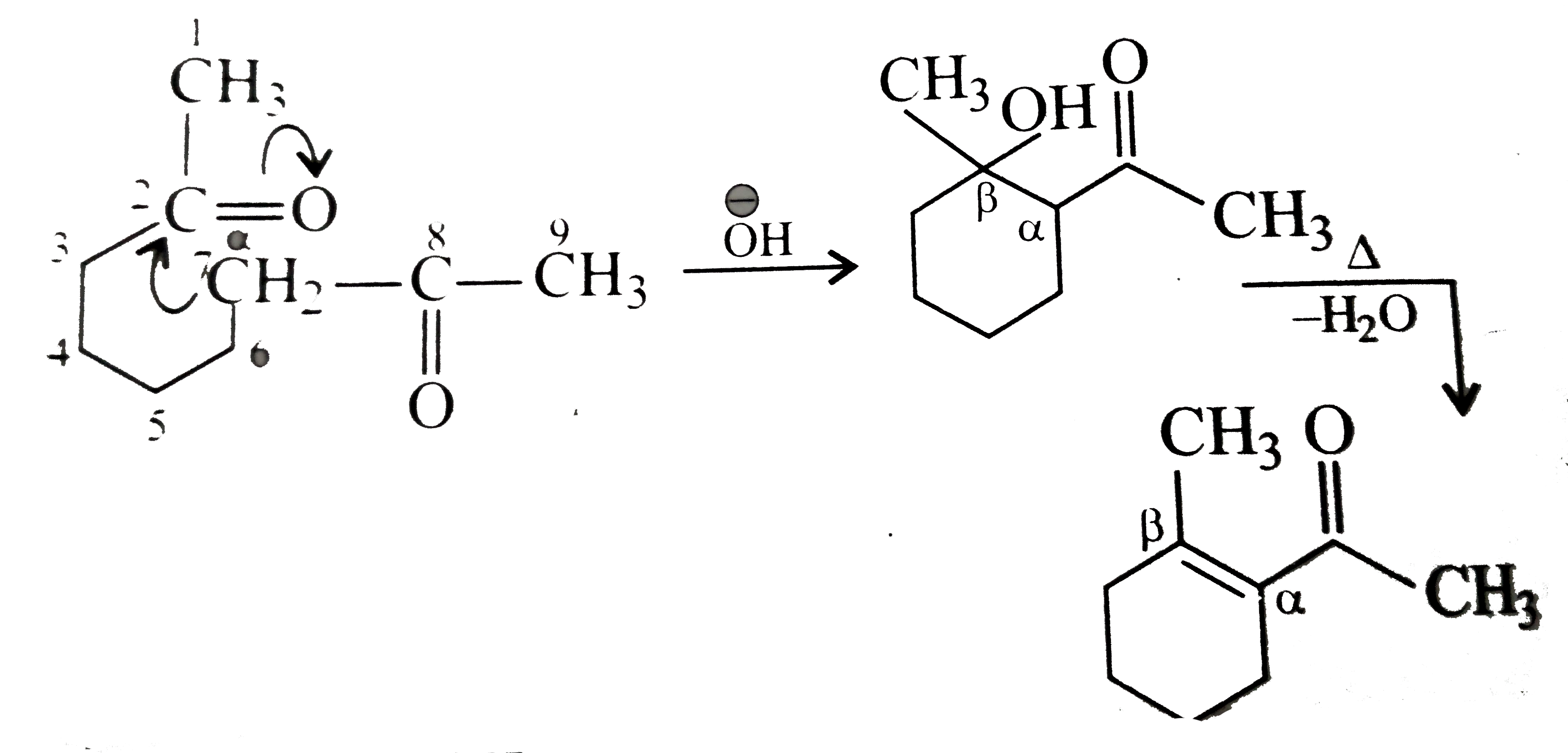 d. `(CH_(3)-CO-CH_(2)-CO-CH_(3))` merely forms the stable carbanion `(CH_(3)-CO-Coverset(..)overset(Θ)H-COCH_(3))` and does not react further. Carbanion does not ADD to C`-4` because a strained four-membered ring be would be formed. 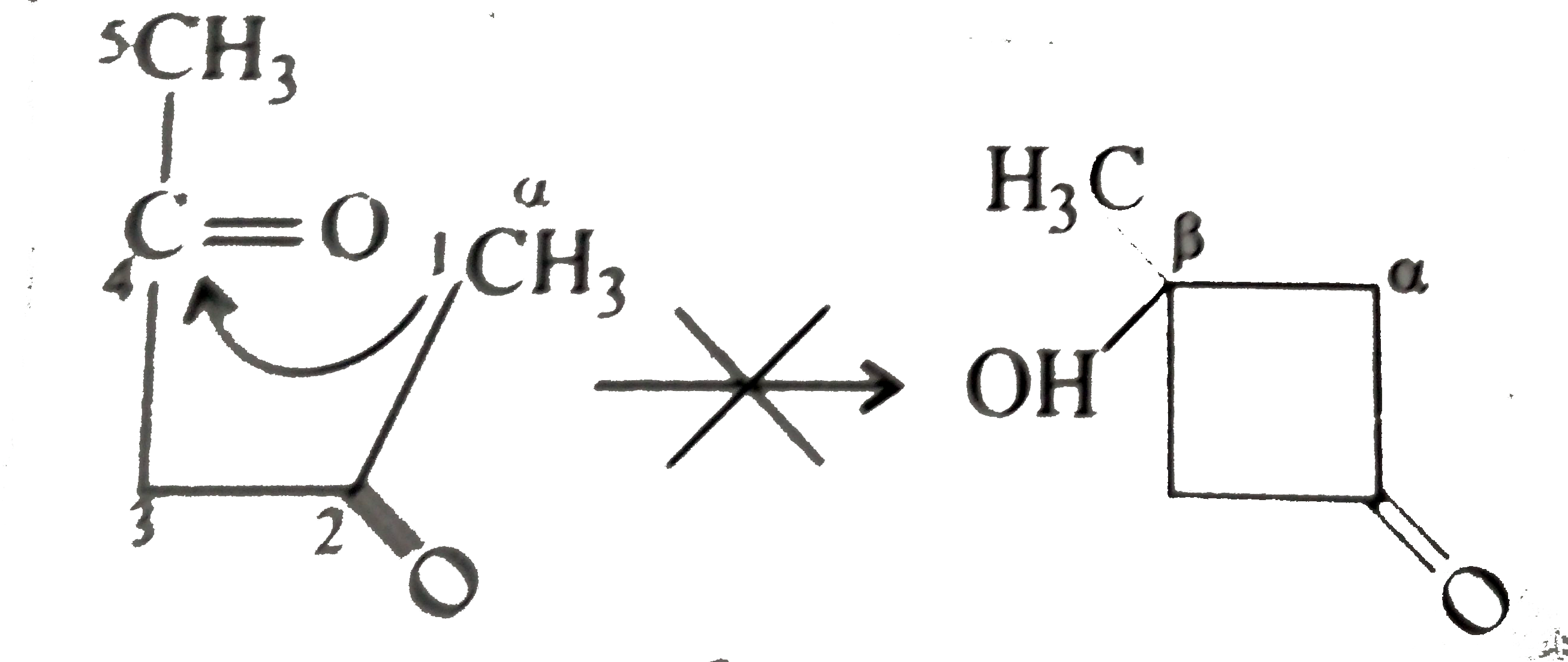 5. i. 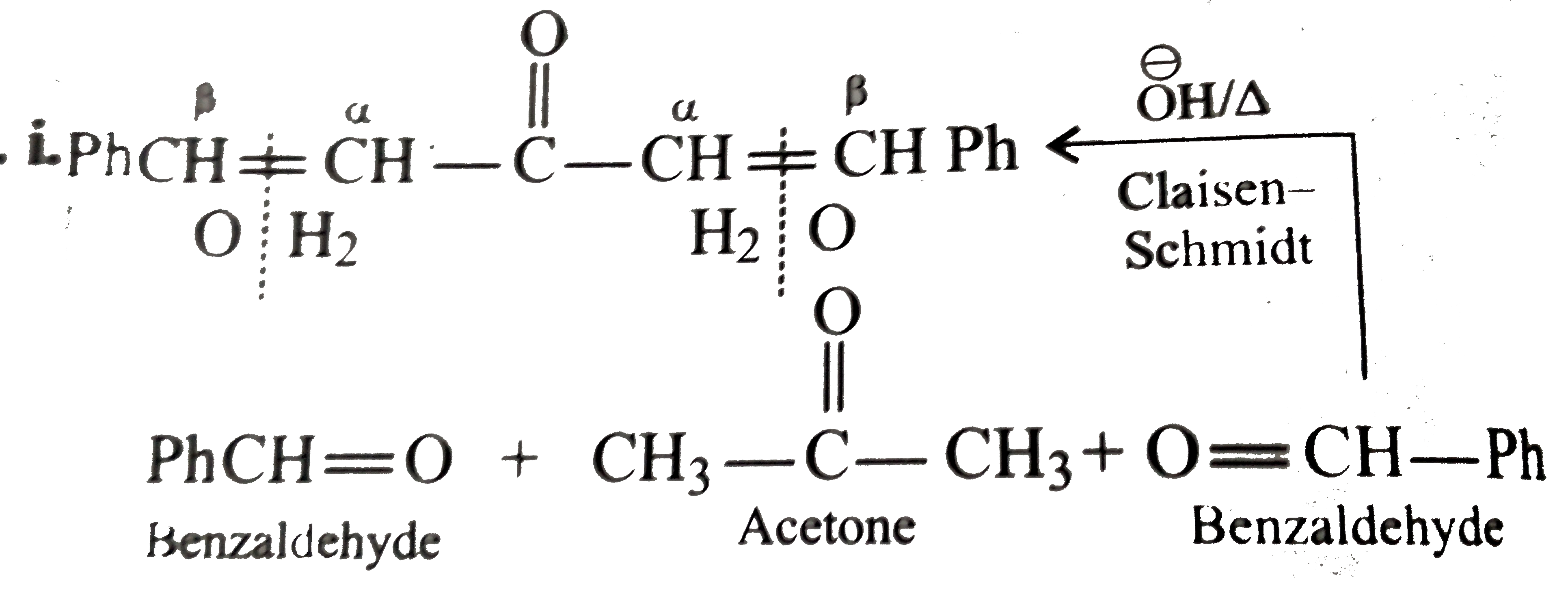 iv.  v. 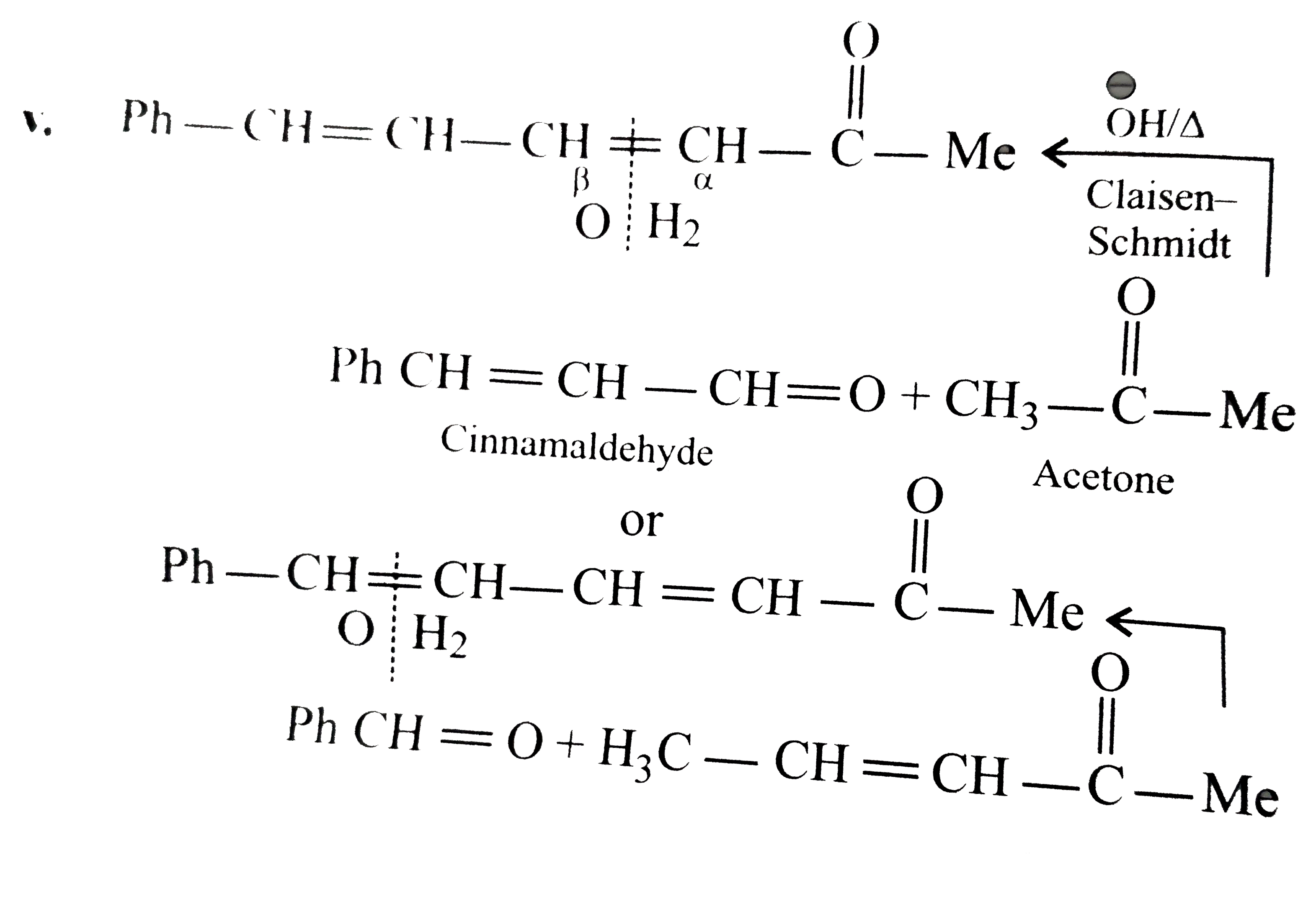 If the adol reaction of `PhCH=O` `(I)` with `CH_(3)CH=CH-overset(O)overset(||)(C)-Me (II)` occurs, two different carbanions (enolate anions) can form `overset(..)overset(Θ)Cunderset(gamma)H_(2)Cunderset(BETA)H=Cunderset(alpha)H-overset(O)overset(||)C-Me (III)` and `CH_(3)CH=CH-overset(O)overset(||)C-underset((alpha))(overset(Θ)(C )H_(2))` (IV). The carbanion (enolate anion) (III) is formed more easily than (IV). The carbanion (III) formed by the removal of `gamma-H` of (II) with base is delocalised to O through the conjugated system giving carbanion enolate. 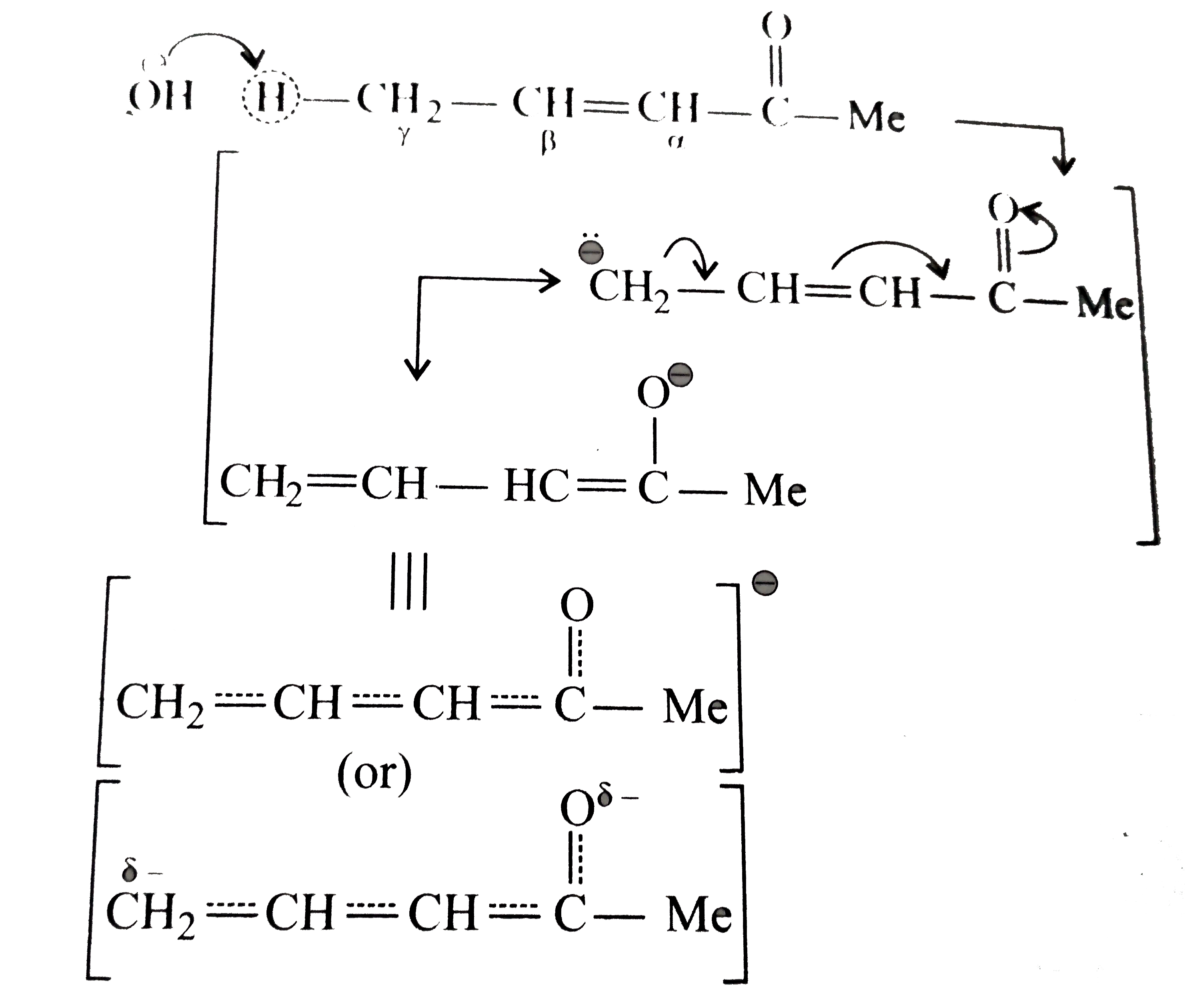 This anion (III) adds to the `(C=O)` of `PhCH=O (I)` to give `delta`-hydroxy alcohol which rapidly loses `H_(2)O` to give the product that is triply conjugated and also is extended-conjugated with Ph group. 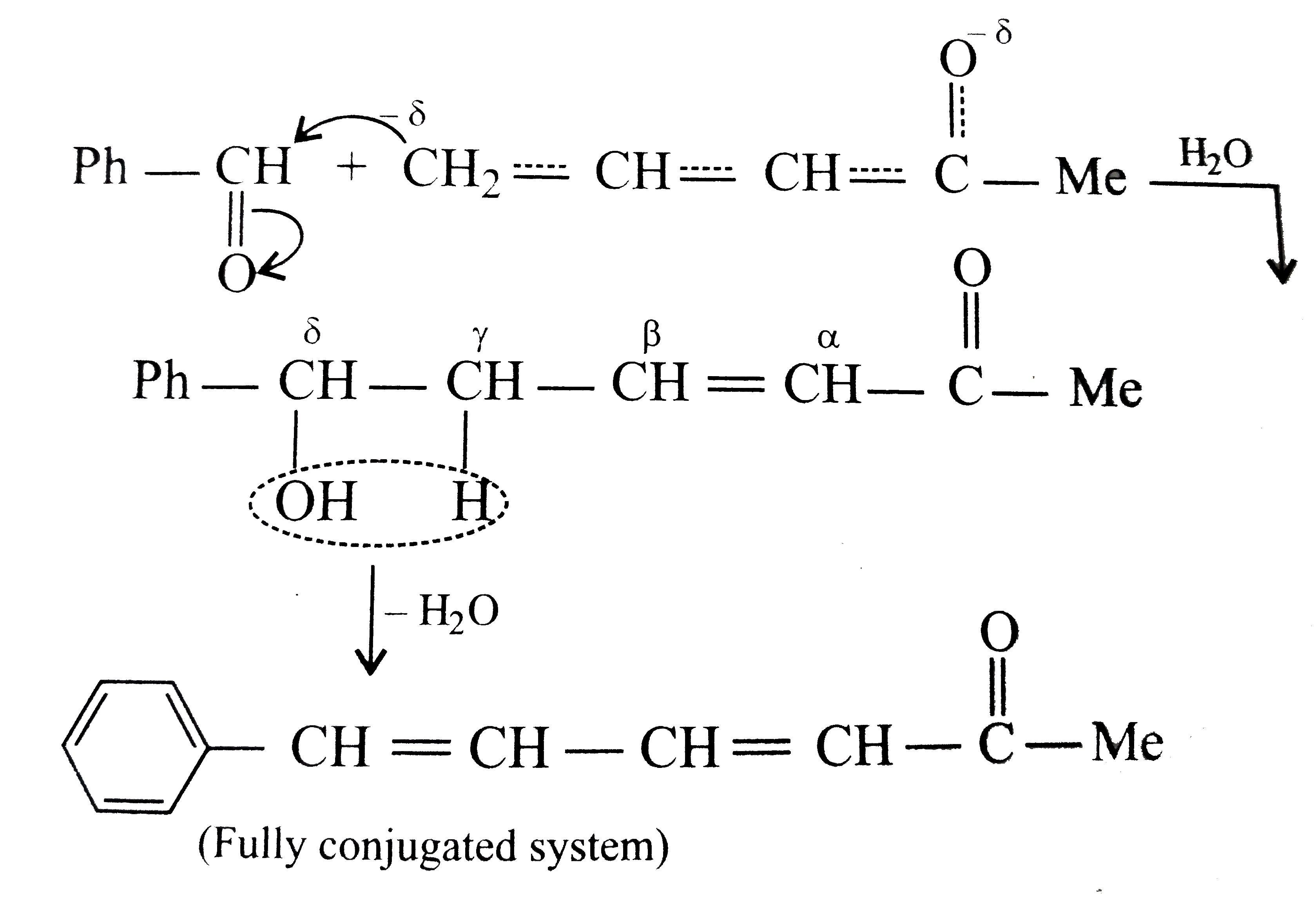 vi.  vii.  ix. 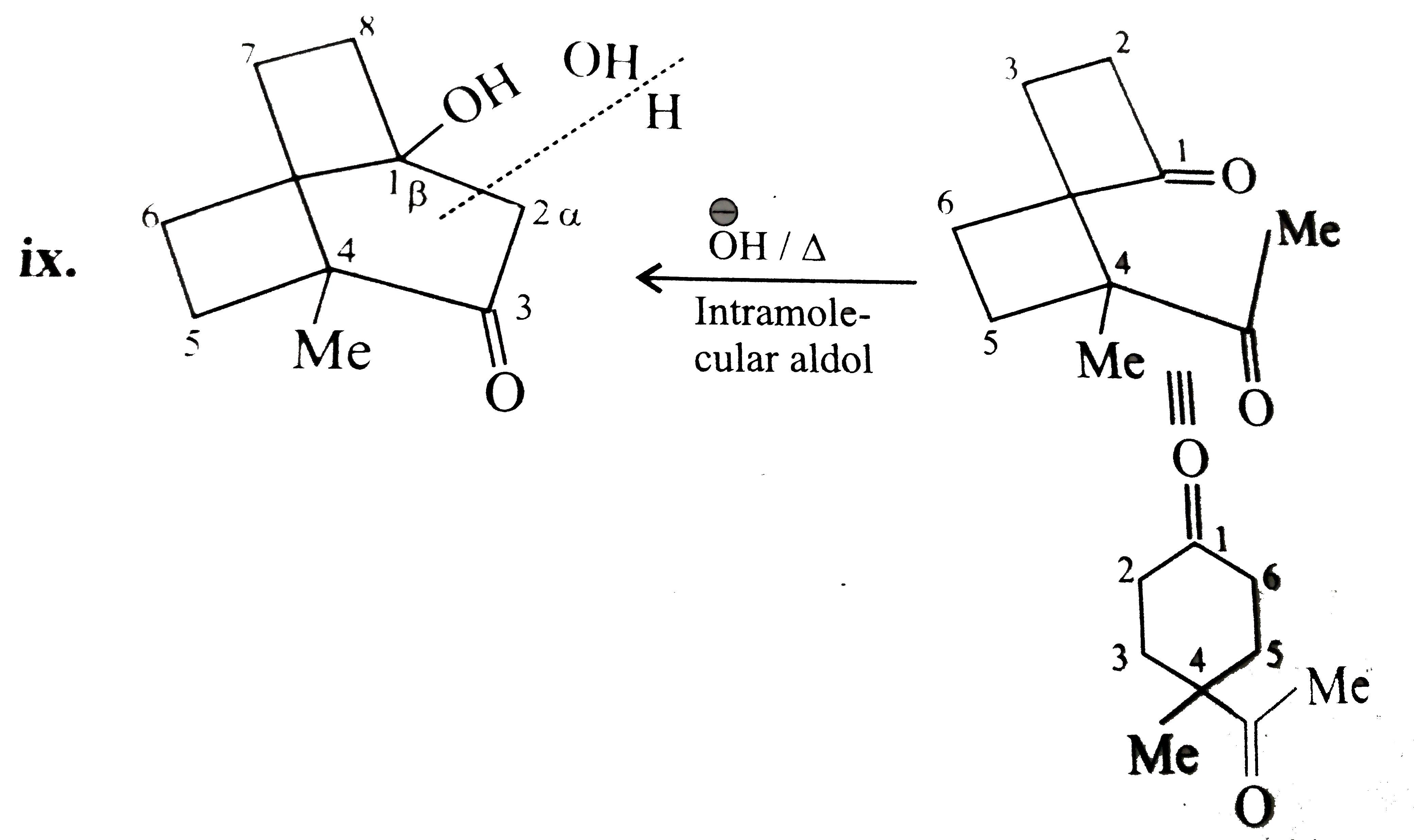 The reactants of the products that cannot be synthesised by aldol condensation: (ii), (iii), and (vii). ii. 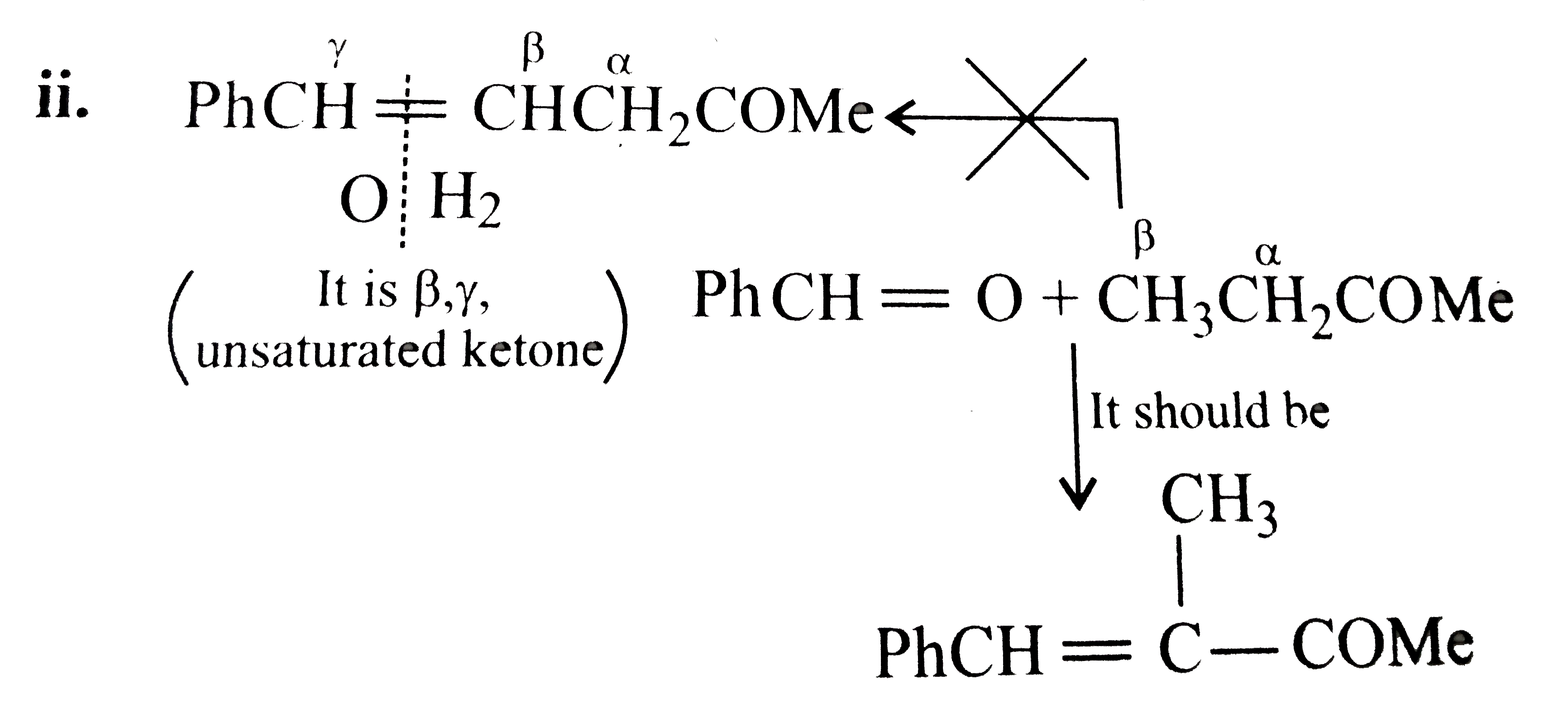 iii.  vii. 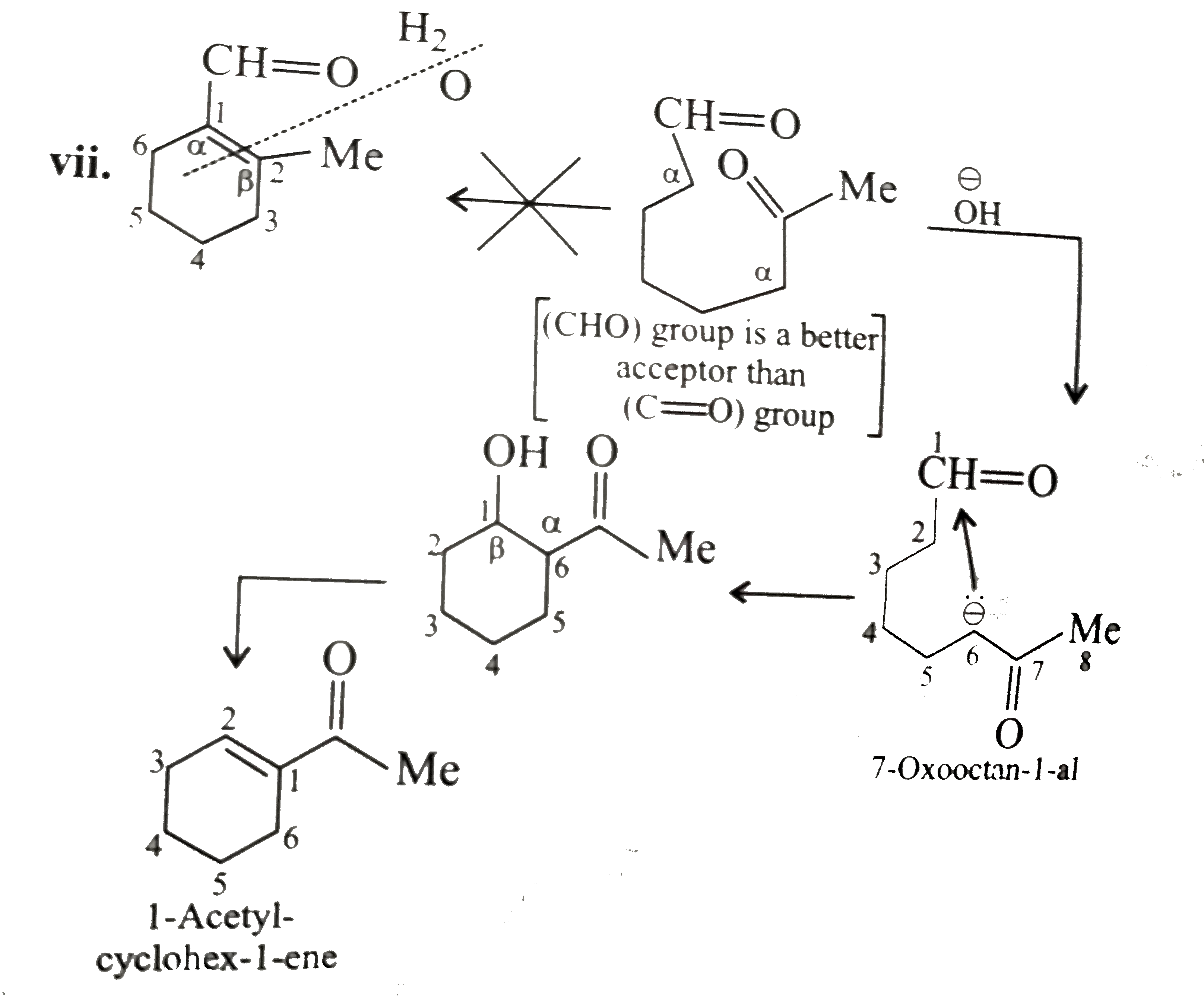 6. 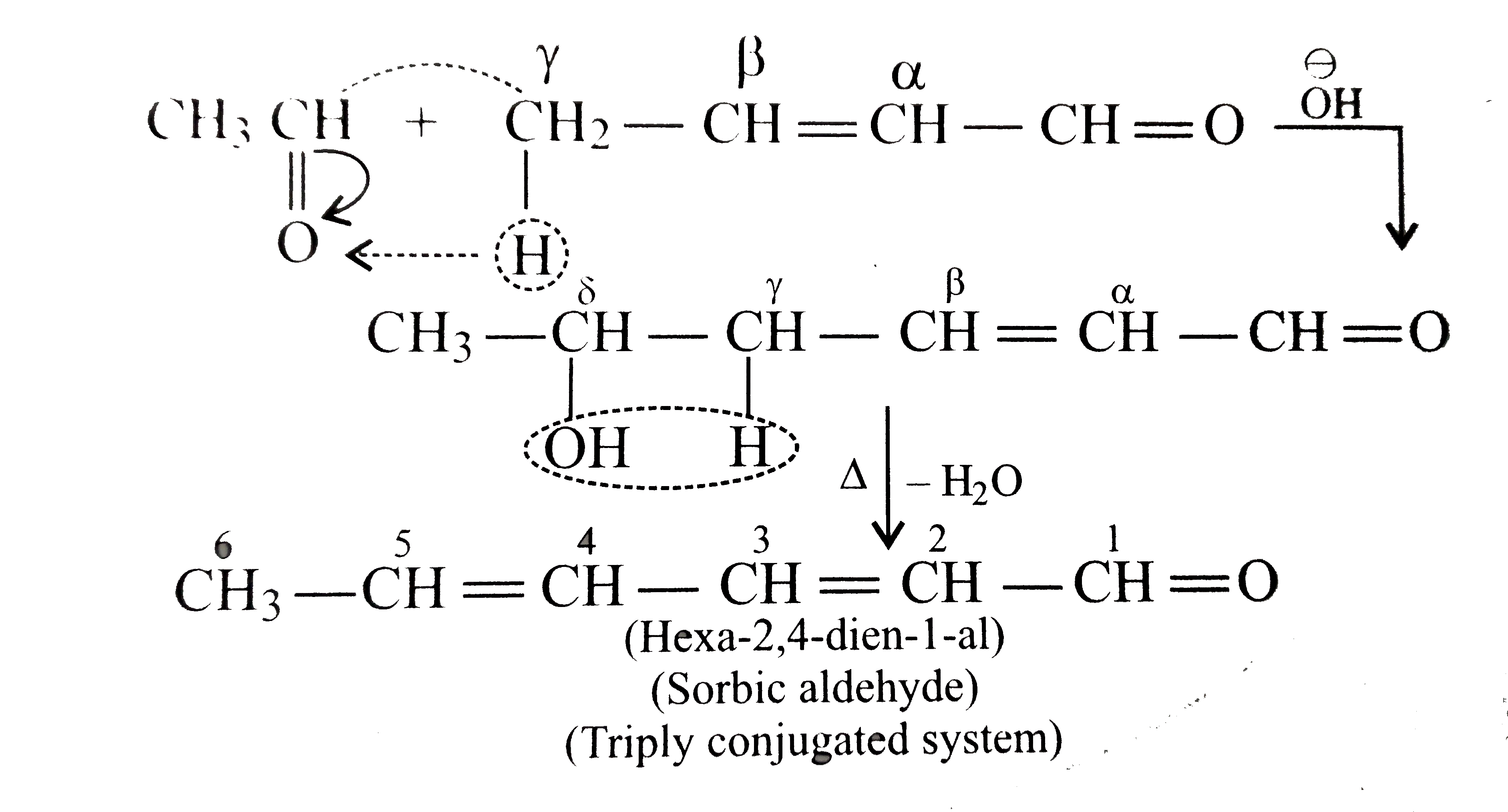
|
|
| 93281. |
Write the relavant chemical equations : 1-iodo butane to n-octane |
| Answer» Solution :`2CH_(3)-CH_(2)-CH_(2)-CH_(2)-I + 2NA overset("ETHER")RARR CH_(3)(-CH_(2)-)_(6) CH_(3)` | |
| 93282. |
1-halobutane and 2-halobutane are |
|
Answer» CHAIN ISOMERS |
|
| 93283. |
1 gram of charcoal adsorbs 100 mL of 0.5 M CH_(2)COOH to from a monolayer and thereby the molarity of acetic acid isreduced to 0.49 M. Calculate the surface area of the charcool adsorbed by each molecule of acetic acid. Surface area of charcoal 3.01xx10^(2)m^(2)//gram. |
|
Answer» Solution :Sept I. Calculation of number of molecules of `CH_(3)COOH` adsorbed. No. of moles of acetic acid initially present `=((0.5mol))/((1000mL))xx(100mL)=0.05 MOL.` No of moles of acetic acid left `=((0.49mol))/((1000mL))xx(100mL)=0.0049 mol.` No. of moles of acetic acid adsorbed = 0.05 - 0.049 = 0.001 mol. No. of molecules of acetic acid adsorbed `=0.001molxx6.022xx10^(23)mol^(-1)` `=6.022xx10^(20)` molecules. Sept II. Calculate of surface AREA of charcoal adsorbed by ONE molecule of acetic acid. According to available data, 1g of charcoal has area `=3.01xx10^(2)m^(2)` Thus, `6.022 xx 10^(20)` molecules of acetic acid get adsorbed on surface area `=3.01xx10^(2)m^(2)` `therefore` 1 molecule of acetic acid gets adsorbed on surface area `=((3.01xx10^(2)m^(2)))/((6.002xx10^(20)))=5.0xx10^(-19)m^(2)` |
|
| 93284. |
1 gram of a carbonate (M_(2)CO_(3)) on treatment with excess HCl produces 0.01186 mole of CO_(2). The moler mass of M_(2)CO_(3) in "g mol"^(-1) is |
|
Answer» 118.6 `0.01186` mole of `CO_(2)` is produced from `M_(2)CO_(3)` `"= 1 g(Given)"` `THEREFORE"1 mole of "CO_(2)" will be produced form "M_(2)CO_(3)` `=(1)/(0.01186)=84.3g` But 1 mole of `CO_(2)` is produced from 1 mole of `M_(2)CO_(3)` `therefore" Molar mass of "M_(2)CO_(3)=84.3"g mol"^(-1)` |
|
| 93285. |
1 gm sample of AgNO_(3) is dissolved in 50 ml of water . It is titrated with 50 ml of Kl Solution : The Agl preciplitated is filtered off . Excess of Kl in filtrate is titrated with M/10 KlO_(3) in presence of 6 M HCl till all l^(-) converted into ICl. It requires50 ml of M/10 KlO_(3) Soluition : 20 ml of the same stock solution of Kl requires 30 ml of M/10 KlO_(3) under similar conditions. Calculate % of AgNO_(3) in the sample . The reaction is KlO_(2) + 2Kl + 6HCl to 3lCl + 3KCl + 3H_(2)O . |
|
Answer» Solution :`AgNO_(3) + Kl to Agl downarrow + KNO_(3)` Ag present in `AgNO_(3)` is removed as Agl by adding 50 ml of Kl solution of which 20 ml requires 30 ml of M/10`KlO_(3)` MEQ. of Klin 20 ml = Meq. of `KlO_(3) = 30 xx 1/10 xx 4` (For `KlO_(3) , l^(5+) + 4e^(-) to l^(+) l_(-) to l^(2+) +2e^(-) ` ) `:." Wq, wt. of " Kl = M/2 ` `:. ` Meq. of Kl in 50 ml added to `AgNO_(3) = (30 xx 4 xx 50)/(10 xx 20) = 30 ` Meq. of Kl left unused by `AgNO_(3) = 50 xx 1/10 xx 4 = 20` ` :. ` Meq. of Kl used for `AgNO_(3) = 30 - 20 = 10` ` :. ` Meq. of `AgNO_(3) = 10` `W_(AgNO_(3))/(170) xx 2 xx 1000 = 10` `:. W_(AgNO_(3)) = 0.85gm= 85 %` `("Moleof " AgNO_(3))/("Mole of " K_(t)) = 1/l` ` :. ` If equivalent WEIGHT of `Kl = M/2` Equivalent weight of `AgNO_(3) = M/2` |
|
| 93286. |
1 gmof charcoal adsorbs 100 mL 0.7 M CH_(3)COOHto form a monolayer, and there by the molarity of CH_(3)COOHreduces to 0.59. Calculate the surface area of the charcoal adsorbed by each molecule of acetic acid in terms of 10^(-19). Surface area of charcoal = 3.01 xx 10^(2) m^(2)//gm. |
|
Answer» Number of moles of acetic acid in 100 ml after adding charcoal = 0.059 Number of moles of acetic acid adsorbed on the surface of charcoal. Number of MOLECULES of acetic acid adsorbed on the surface ofcharcoal = `0.011xx 6.02 XX 10^23 =6.62 xx 10^21` Surface area of charcoal = `3.01 xx 10^2 m^2` (given) Area occupied by single acetic acid molecule on the surface of charcoal `=(3.01 xx 10^(2))/(6.62 xx 10^(21)) = 0.45 xx 10^(-19) m^(2)` |
|
| 93287. |
1 gm metal carbonate requires 200 ml of 0.1N HCl for complete neutralization. What is the equivalent weight of metal carbonate:- |
|
Answer» 50 `(1)/(E)=200xx10^(-3)xx0.1` `E=(1)/(0.02)=50` |
|
| 93288. |
(1) Give structure and IUPAC name of an optically active alkane having lowest molecular mass. Is there another alkane of the same molecular mass that is also optically active? (2) Give example of a compound which exhibits both optical & geometrical isomerism. |
|
Answer» Solution :Such compound must contain an asymmetric CARBON atom which will remain ATTACHED to a H - atom and three different alkyl GROUPS (smaller size). So, optically active alkane having lowest molecular mass is 3 - methylexane `[CH_(3)CH_(2)overset(**)(C)H(CH_(3))CH_(2)CH_(2)CH_(3)]`. Another optically active alkane with the same molecular mass is 2,3 - dimethylpentane `[CH_(3)CH_(2)overset(**)(C)H(CH_(3))_(2)]` which is a chain isomer of the first one. (2)Pent - 3 - en - 2 - ol `[CH_(3)overset(**)(C)H(OH)CH=CHCH_(3)]` exhibits both geometrical and OPTICAL isomerism because the compound CONTAINS as asymmetric carbon atom and each of the doubly bonded carbon atoms is attached to two different groups. |
|
| 93289. |
1 game of a carbonate (M_(2)CO_(3)) in g mol^(-1) is :- |
|
Answer» `1186` |
|
| 93290. |
1 g of pure calcium carbonate was found to require 50 ml of dilute HCl for complete reactions. The strength of the HCl solution is given by : |
|
Answer» 4N |
|
| 93291. |
1 g of metal was diluted in 100 ml of N/2 HCI. The solution was diluted to 500 ml. 24 ml o this solution requires 20 ml of N/10 NaOH. The equivalent mass of the metal is: |
|
Answer» 50 |
|
| 93292. |
1 g of metal, having no variable valency, produces1.67g of its oxide when heated in air. Its carbonate contains 28.57% of the metal. How much oxide will be obtained by heating 1g of the carbonate? |
|
Answer» i.e., x=0.1914g of oxygen Mass of oxide `=0.2857+0.1914=0.4771g` |
|
| 93293. |
1 g of hydrogen is found to combine with 80g of bromine 1 g of calcium combines with 4 g of bromine. The equivalent. Mass of calcium is: |
|
Answer» 10 |
|
| 93294. |
1 g of hydrogen is found to combine with 80 g of bromine. 1 g of calcium (valency=2) combines with 4 g of bromine The equivalent weight of the calcium is : |
|
Answer» 10 |
|
| 93295. |
1 g of helium gas is confined in a two-litre flask unser a pressure of 2.05 atm. What is temperature ? |
|
Answer» |
|
| 93296. |
1 g of charcoal adsorbs 100 ml of 0.5 M CH_(3)COOH to form a monolyer, and thereby the molarity ofCH_(3)COOH reduces to 0.49 M. Calculate the surface area of the charcoal adsorbed by each molecular of accetic acid. Surface area of charcoal =3.01xx10^(2)m^(2)g. |
|
Answer» Solution :100 ML of `0.5 M CH_(3)COOH` ontains `CH_(3)COOH=0.05` mole After adsorption, `CH_(3)COOH` present `=0.049` mole `therefore` Acetic acid adsorbed by 1 g charcoal `=90.05-0.049)` mole3 `=0.001` mole `=6.02xx10^(20)` molecules Surface area of 1 GOF charcoal `=3.01xx10^(2)m^(2)` `therefore` Surface area of charcoal adsorbed by each MOLECULE `=(3.01xx10^(2)m^(2))/(6.02xx10^(20))=5xx10^(-19)m^(2)` |
|
| 93297. |
1 g of an organic compound containing oxygen is heated with graphite and carbon monoxide formed is quantitatively converted to 0.1375 g CO_(2) on reaction with I_(2)O_(5) calculate the percentage of oxygen in the compound. |
|
Answer» |
|
| 93298. |
1 g of an organic compoud on treatment with fuming nitric acid and BaCl_(2) solution gave 0.29125 g of BaSO_(4) calculate the percentage of sulphur in the compound. |
|
Answer» |
|
| 93299. |
1 g of a monobasic acid in 100 g of water lowers the freezing point by 0.168^(@). If 0.2 g of the same acid requires 15 mL of N/10 alkali for complete neutralisation, the degree of dissociation of the acid is (K_(f)" for water "="1.86 K kg mol"^(-1)) |
|
Answer» `9.8%` `=(1000xx1.86xx1)/(100xx0.168)=110.71` i.e., Observed MOLECULAR mass= 110.71 15.1 mL of `(N)/(10)` alkali neutralise acid = 0.2 g `=(0.2)/(15.1)xx1000xx10=132.45g` `therefore"Eq. wt. of the acid = 132. 45"` Mol. mass of the acid = 132.45 (as it ismonobasic) This is calculated (NORMAL) mol. mass `i=("Normal mol. mass")/("Observed mol. mass")=(132.45)/(110.71)=1.196` `{:(,HA ,hArr,H^(+),+,A^(-)),("Inital",1,,0,,0),("After disso. ",1-alpha,,alpha,,alpha),(,,,,,"Total "=1+alpha):}` `therefore i=1+alpha or alpha=i-1=0.196=19.6%` |
|
| 93300. |
1 g of a metal M which has specific heat of 0.06 combines with oxygen to form 1.08g of oxide. What is the atomic mass of M? |
|
Answer» SOLUTION :Approximate atomic MASS `=(6.4)/(0.06)=106.6` Equivalent mass of `M=(1)/(0.08)xx8=100` Valency`=(106.6)/(100)=1` EXACT atomic mass `=100xx1=100` |
|
